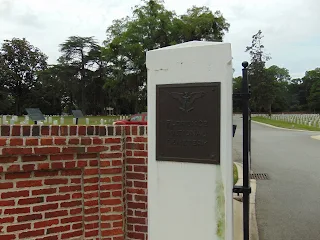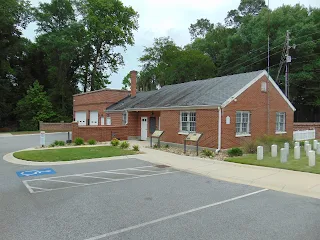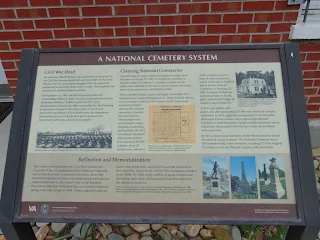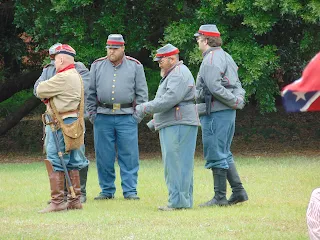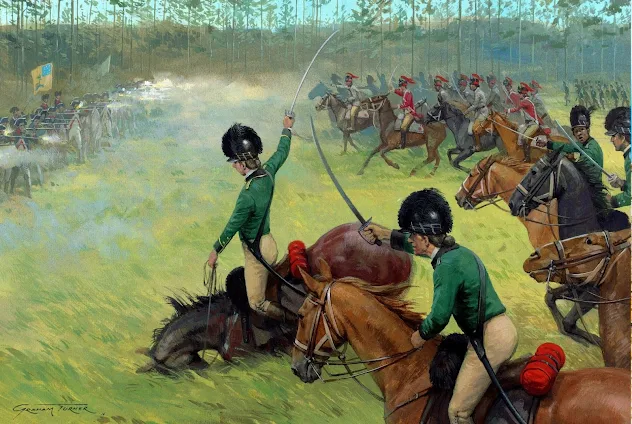 |
| The British Legion charges Virginia Continentals at the Battle of the Waxhaws on May 29, 1780. Painting by Graham Turner. |
The Massacre At The Waxhaws
Monday, May 29, 1780
After five years of largely indecisive fighting in the northern States, the Revolutionary War reached a stalemate in the year 1780. George Washington's Continentals faced off against the combined British and Hessian forces now under the command of General Sir Henry Clinton outside of New York City.
France and Spain had entered the war on the side of the newly independent American States in 1778 and the British Empire reoriented for a worldwide strategy. Losing the North American colonies would be bad; but the loss of Gibraltar, India, or the West Indies would have been a disaster for Great Britain. British troops and naval vessels were needed on other more important fronts.
General Clinton knew that there might still be a way to win the war for America: conquer the South. The region had been largely untouched by the war, and it was felt that in the Southern States there were yet many Loyalists who would rise to support the Crown if the British army established a serious foothold there.
 | |
| General Sir Henry Clinton, Commander In Chief of British Expeditionary Forces in North America 1778-1782. Painting by English painter John Smart. |
On Sunday, April 2, 1780, a British armada and expeditionary force under Clinton's direct command launched his attack against the city of Charleston, South Carolina. Unlike Clinton's previous attack in June of 1776, this time the British forces laid siege to the city with both infantry and naval forces trapping the main Southern Continental Army under the command of Major General Benjamin Lincoln.
On Friday, May 12th at around 11:00 AM, Lincoln surrendered the city and the entire Southern Continental Army after a six week siege. Lincoln's army included all four of South Carolina's remaining Continental regiments, two North Carolina Continental regiments and six Virginia Continental regiments, as well as a large number of North and South Carolina militia -- overall about 5,000 men.
The surrender of Charleston sent a shock wave throughout the entire continent. Charleston was the largest and most important city in the South -- still the capitol of the newly independent State of South Carolina at that time -- and its loss was a huge blow to the morale to the Continental Congress and the cause of American independence. The loss of the entire Southern Continental Army would be considered single the worst American military defeat in history until the fall of Bataan and Corregidor in the Philippines in May of 1942 (the final surrender of the C.S.A. armies in April and May of 1865 aside that is).
Under the terms of the surrender, the Continental regulars were to remain as prisoners of war until properly exchanged, but the Patriot militiamen were to be permitted to return to their homes as prisoners on parole provided they sign a pledge not take up arms against the British Crown again. Many took the offer of parole and went home, feeling that the war was over for them. Other backcountry Patriots upon learning about the defeat at Charleston simply turned around and went home.
There were still some Patriot troops outside the city under the command of Brigadier General Issac Huger who had not surrendered with the rest of Lincoln's army. These troops also included the remnants of Lt. Colonel William Washington's Continental dragoons and a few companies of militia including a company commanded by Captain John McClure from what are now present-day Chester and York Counties. Having no further use for them, Huger dismissed the militia. Devastated by the loss of their State's capitol, and angered at the loss of their horses in battle less then a week earlier, McClure's company broke camp and began the long walk home. At the time many of them felt that the war was lost in South Carolina.
The remains of Huger and Washington's Continental forces retreated to Lenud's Ferry on the Santee River where they would meet up with a force of Virginia Continentals under the command of Colonel Abraham Buford and North Carolina militia commanded by William Caswell.
Buford's Virginians and the Retreat
Raised in Virginia earlier in the spring, Buford's command consisted of about 380 Continental officers and men of the 3rd Virginia Detachment which included the 7th Virginia Regiment, two companies of the 2nd Virginia regiment and a small force of artillerymen with two six-pounders. Many of these men were recruits with little battle experience, though Buford himself saw battle before in Washington's Continental Army.
Due to delays in getting his command organized and outfitted, Buford and his army did not even arrive in South Carolina until the beginning of May and was unable to reach Charleston in time to help in its defense. By the time the Virginians arrived at Lenud's Ferry, the city had fallen to the British. Buford's men were joined by about 40 Virginia Light Dragoons who had escaped the siege. A total of 420 men overall.
 |
| A battle flag of Buford's 3rd Virginia Detatchment. The original banner (one of three) was captured by Tarleton's British Legion at the Battle of the Waxhaws. |
Huger, Washington and Buford met up at Lenud's Ferry that evening. Their combined forces were too small in number to resist the British so retreat was their only option. Huger ordered the Virginians and North Carolina militia to withdraw to Camden, South Carolina retreating north along the river, toward the High Hills of Santee, before the British could cross the river and overtake them. Marching north they came to the Great Wagon Road that led from Charleston to the Camden District and the upstate settlements. Both Washington and Huger went ahead to Hillsborough, North Carolina where the few remains of the Southern Continental Army that was not captured were gathering to regroup and gather into a new army.
On Friday, May 26, Buford, Caswell, and their men arrived in the town of Camden where they encountered South Carolina Governor John Rutledge who'd managed to escape from Charleston before the surrender and took refuge there to assume direction of the remaining soldiers there.
Governor Rutledge informed Buford of rumors that the British army was in pursuit and advancing on Camden in force. He decided the best chance for them to escape was to separate the units and take two different routes. Caswell's brigade was to march northeast to the Pee Dee River and towards North Carolina while Buford's Virginians were to satay on the Great Wagon Road to Salisbury, North Carolina. Rutledge would go with them and establish a government in exile in North Carolina to continue fighting the British from there.
The British Advance
Receiving intelligence from Loyalist spies that Buford and Rutledge were in Camden and preparing to retreat to North Carolina, Clinton ordered his second-in-command Lieutenant General Charles Lord Cornwallis, along with a corps of some 2,500 infantry, cavalry, and artillery, to follow Buford and neutralize his force. Clinton and Cornwallis were both in agreement that the pacification of the South Carolina "backcountry" and upstate was of major importance to the success of their campaign. Having an armed force of Continentals close by would only encourage those "rebels" left in South Carolina to continue their resistance to the Crown.
On Thursday, May 18th, Cornwallis' forces made their way to Lenud's Ferry and crossed the Santee River headed for Camden. Heavy rains slowed the British pursuit and Buford's retreat since both forces were burdened by artillery and wagons on muddy roads.
By Saturday, May 27th, Cornwallis realized that his main army was advancing too slowly to catch Buford, so he detached the British Legion, a mobile force of cavalry and infantry made up of Northern-born American Loyalists from New York, New Jersey and Pennsylvania commanded by British Lieutenant Colonel Banastre Tarleton, to pursue Buford's force while he marched the rest of the army to Camden and being the task of establishing British outposts in the upcountry to maintain order for the Crown's forces.
Tarleton's command included 40 British cavalry regulars of the 17th Dragoons, 130 of his British Legion Cavalry, and 100 men of the British Legion's Infantry detachment - riding double with a cavalryman on horseback for this occasion. A total of 270 men overall.
 | |
| British Lt. Colonel Banastre Tarleton wearing the green uniform of the British Legion that earned him the romantic nickname: "The Green Dragoon". The actions of his men at the Waxhaws on May 29, 1780 would earn him several less flattering nicknames in American history such as: "Bloody Ban" or "Butcher Tarleton". Painting by British painter Sir Joshua Reynolds. |
At about 10 AM on Sunday, May 28th, then 11-year-old Thomas Sumter Jr., the young son of Colonel Thomas Sumter, was riding his horse through the High Hills of the Santee River when a neighbor rode past in full gallop, crying that British cavalry was on its way. Tom rode his horse home to inform his father what he had heard. Sumter called to Soldier Tom, his African-American manservant, and ordered him to saddle their horses. After donning his old uniform of the 2nd South Carolina Regiment, Sumter bid farewell to Tom and his wife, Mary, and headed to North Carolina with Soldier Tom only a few hours ahead of the British Legion.
Although Sumter had retired from active military service in September 1778, he was well known to the British and Loyalists in South Carolina as a prominent Continental officer. Tarleton dispatched Captain Charles Campbell of the Legion to bring in Sumter. Campbell's detachment arrived at Sumter's plantation home to find Sumter had already alluded them. The British Legion soldiers then plundered the home and put it to the torch, leaving Sumter's family homeless.
The destruction of Sumter's home would be just one of several mistakes the British Legion would make in the next two days that would have major long-term repercussions in derailing their overall Southern strategy.
That evening Tarleton reached Camden and wasted no time in setting off after Buford. He departed the town at about 2 AM the next morning on Monday, May 29th.
Buford's forces, along with Governor Rutledge, were camped at a place called Hanging Rock, a small creek overhung by a huge conglomerate boulder just 20 miles north of Camden.
 |
| A copy of the terms offer to Buford by Tarleton on the afternoon of May 29, 1780 prior to the Battle of the Waxhaws. Courtesy of the Museum of the Waxhaws collection. |
Around midday an officer of the British Legion, Captain David Kinloch, under a banner of truce, came upon Buford's force with a message from Tarleton -- who by that time was at Barkley's tavern on the road less than an hour behind Buford. The message was clear, Buford could surrender on generous terms -- about the same given by Clinton to Lincoln at Charleston -- or, as Tarleton boldly phrased it in his message: "If you are rash enough to reject them, the blood be upon your head."
Buford and his junior officers conferred. They claim by Tarleton in his message of having 700 men, they guessed correctly, was a lie. In fact, Buford's Virginians actually outnumbered the British Legion detachment close to 3 to 1. Buford believed that the whole thing might be a ruse to bluff them to surrender. Buford declined the offer to surrender with a one sentence reply: "Sir, I reject your proposals, and shall defend myself to the last extremity."
The Battle of the Waxhaws
 |
| Virginia Continental Soldier. Artwork by Don Troiani. |
Sometime around 3 PM that afternoon, a bugle sounded behind them, and Tarleton's 170 cavalrymen, sabers swinging, charged the Virginian's read guard, commanded by Lieutenant Thomas Pearson.
In 18th century warfare, cavalry charges against infantry were a terrifying experience for the men on foot. Psychologically such an attack is meant to play on the nerves and strike terror into infantry soldiers. The sight of being attacked at high speed by a screaming, sword-wielding enemy riding a large horse, or other beast, is almost more than most people can stand up to.
Some of the Virginians ran, others dropped to the ground to avoid the British sabers. Lieutenant Pearson himself was not so fortunate. He was mounted himself and was knocked from his horse by a saber blow and then slashed across the face, the sword cutting his nose and lips in half and killing him instantly.
Buford halted his main column and ordered the Continentals to turn and form on the side of the road under the trees facing the enemy. In haste to do so, Buford either had no time to order the wagons to be used as an obstacle, nor get his two cannons in place. Tarleton deployed his men into three elements of combined cavalry and infantry, then attacked from about three hundred yards. The British Legion Cavalry charged the front and flanks of the Virginians.
As they charged, Buford gave what was perhaps a fatal order: hold fire until the enemy was ten paces in front of the line. By that time the cavalry was charging the line at full gallop and could not be stopped. The Continentals got off one volley of shots before the Legion's cavalry crashed into the line, British sabers went to work on the now all-but helpless Virginia infantry who had no time to reload their muskets. The two flanking units of the British line then all but surrounded the Continentals. By that point the charging Legion Infantry joined in jabbing anything that moved with their 15 inch bayonets.
 |
| British Legion Infantry Soldier. Artwork by Don Troiani. |
During the volley, Tarleton's horse was shot out from under him and he fell to the ground with his dead horse on top of him, pinning him down for the next few moments. The Legion's soldiers seeing their young commander shot down and believing him to be dead turned on the Virginians and began to literally hack them to pieces, some even as they tried to surrender.
Buford himself did not wait to see the final outcome of the battle knowing that defeat was inevitable. He galloped away towards Salisbury on horseback with a few survivors leaving the infantrymen to their fate.
Lieutenant Colonel Tarleton -- now mounted onto a fresh horse -- finally urged his officers to get the men under control. This took some time in the heat and confusion of battle with tempers flared and adrenaline pumping. The battle became a bloody melee with the Legion Cavalry slashing at survivors with sabers and the infantry stabbing with bayonets in hand-to-hand combat. Some were hacked to death, or wounded by bayonets when they raised their hands and tried to surrender.
When the smoke cleared, 113 of the Virginia Continental soldiers were dead -- many of which would die later from wounds -- 150 men were wounded and 53 were captured. Only a handful escaped with Buford. Of the British Legion, 5 men lay dead (probably from the volley by the Virginians) and 12 wounded.
The entire battle took less then fifteen minutes.
 |
| British Legion Cavalry charging down Buford's Virginian Continentals. |
The Bloody Aftermath
Tarleton ordered that the 53 Continentals still standing be transported to Camden where Cornwallis was setting up command of South Carolina. The 150 men that lay wounded -- some too badly to be moved any great distance -- were "paroled" which largely meant in many cases leaving them on the field to die.
By nightfall the British Legion camped closed to the battleground. Tarleton sent messengers over to the nearby Waxhaw community thirteen miles away to inform the residents of the battle. At a distance from the Legion's fires, dead and wounded still lay on the earth, the later screaming in torment. Tarleton sent for surgeons from Camden and Charlotte to help assist the wounded. His own Legion's doctor was busy helping with the fourteen wounded men of the Legion and did not bother with helping the enemy, the Hippocratic Oath notwithstanding.
 |
| Marker outside the Waxhaw Presbyterian Church, site of Waxhaws Meeting House in 1780. |
Among the local Waxhaw residents who helped with caring for the badly wounded Virginian Continentals was a local widow named Elizabeth Hutchinson Jackson and her 13 year old son, Andrew Jackson -- the future 7th President of the United States -- who would later join with local patriots under Thomas Sumter's command to fight against the British and Loyalists in the upstate.
Conclusion: "Tarleton's Quarter"
To the local residents, the sight of so much bloodshed, and young men literally cut to pieces was a scene of horror none of them would ever forget. For the people of upstate South Carolina up until then the Revolutionary War was only know to them from family and neighbors who went off to fight far away through letters or second hand accounts.
For the first time since South Carolina declared her sovereign independence, eighteenth century warfare finally arrived literally in the back yards of the people of the South Carolina upcountry. These people now witnessed first hand the type of war and brutality practiced their new British masters.
In the aftermath of the Battle of the Waxhaws -- or "Buford's Massacre" as its still called in upstate South Carolina to this day -- both frightened and angered many backcountry Patriots, many of whom believed that Tarleton deliberately ordered his men to slaughter Buford's Continentals. The fact that Tarleton himself played up the one-sided battle and encouraged the stories of his men's slaughter of the Virginians would not help to dispel these perceptions.
The one-sided battle earned the young English Colonel the nickname he would forever be known in South Carolina history: "Bloody Ban" Tarleton.
To the upcountry Patriots, the name Tarleton and the green-coated British Legion would be synonymous with terror. Worse for the British and their Loyalist allies, it would plant the seed of defiance in the hearts of Southern Patriots and a determination to expel an enemy capable of such wanton cruelty.
The bloody melee at the Waxhaws would be the prelude to nearly three years of bloody partisan fighting in the South Carolina backcountry, a civil war between Patriots and Loyalists that would reach it's peak from Buford's bloody battleground to the top of Kings Mountain five months later.
"Remember Tarleton's Quarter" would also become a rallying cry for a new wave of defiance in upstate South Carolina among Patriots waiting for the opportunity to strike back against the British and their Loyalist allies.
One of the very first acts of retaliation would come just over a week later at a placed called Alexander's Old Field in modern-day Chester County, which this blogger will tell you about in the next chapter of this series.








